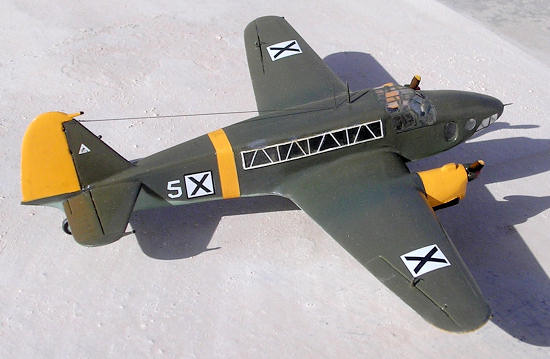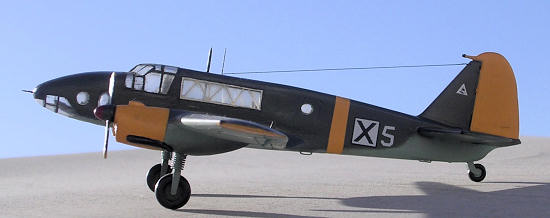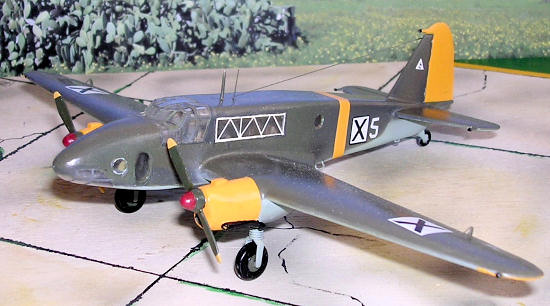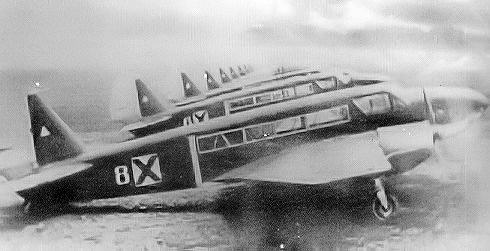 The
KB 309 was basically a license built aircraft at the Kazastak factory of the
Italian Ca 309.The original Ca 309 aptly named Ghibli (desert wind), 78 of
which were built between 1936-1938 for use in Libya. There were two civil
examples and 165 built for the Regia Aeronautica during the war years. Two
were supplied to Paraguay
in 1938. When Italy
entered the war in 1940 there were seven squadrons equipped with the Ghibli.
The
KB 309 was basically a license built aircraft at the Kazastak factory of the
Italian Ca 309.The original Ca 309 aptly named Ghibli (desert wind), 78 of
which were built between 1936-1938 for use in Libya. There were two civil
examples and 165 built for the Regia Aeronautica during the war years. Two
were supplied to Paraguay
in 1938. When Italy
entered the war in 1940 there were seven squadrons equipped with the Ghibli.
The Bulgarian built
version, the KB 309 started its test flight on
the 28th November 1940.
The original features of the Italian Caproni were retained. These comprised
mixed construction and fixed landing gear. The principal difference on the
KB 309 was the power plants. The original low power Alfa 115 being replaced
by the German Argus AS 10C. This was a 240 hp air cooled 8 cylinder inverted
‘V’ engine, which was ide ntical
power plant used on the FW-58 B/E. The Papagal KB 309, was also commonly
known or the KB-6 and was the only twin engine type to be made in
Bulgaria. The new power plant increased the
power by about 30% which resulted in improved performance such as rate of
climb, and also increase in service ceiling of 21,325 ft, being attained as
against 13,945 ft with the original Italian engines.
ntical
power plant used on the FW-58 B/E. The Papagal KB 309, was also commonly
known or the KB-6 and was the only twin engine type to be made in
Bulgaria. The new power plant increased the
power by about 30% which resulted in improved performance such as rate of
climb, and also increase in service ceiling of 21,325 ft, being attained as
against 13,945 ft with the original Italian engines.
The KB 309 had a cabin for six passengers and
fitted with windows on both sides. Other minor modifications included a 10
cm longer fuselage, a reduced lower fuselage tail end which involved a small
reduction in the lower fin and rudder area. There were minor changes to the
leading edge at the wing root area, removal of fairings on the main landing
gear, and a redesigned nose with transparent glazing. Nine examples were
built serialled 1/7024 to 9/7024. The Papagal remained in service for seven
years up to the late 1940s during which it was used as a trainer, ambulance
plane, and liaison duties and on occasions also as a light bomber where it
was armed with a 7.7mm machine gun, two of which were fixed in the wing root
and could carry a bomb load of 660 Lb. The recce version was equipped with a
camera in the nose.
 There
is no known kit of the Caproni 309 at the scale of 1/72. In the
understanding that the Ca 313 evolved from the earlier Ca 309 and Ca 310
variants, a study of scale plans of the two aircraft types gave good
indications that the Italeri kit of the Ca 313 could be used to produce the
Bulgarian KB 309 which was a direct development of the Ca 309. The KB 309
was not the type that mainstream kit manufacturers, or those from the
cottage industry could ever throw their efforts to produce since the type
was moderately successful, poorly armed and therefore not so known in combat
service and few were built to the Bulgarian Air Force.. Yet no Bulgarian Air
Force collection will be complete without presence of the KB 309.
There
is no known kit of the Caproni 309 at the scale of 1/72. In the
understanding that the Ca 313 evolved from the earlier Ca 309 and Ca 310
variants, a study of scale plans of the two aircraft types gave good
indications that the Italeri kit of the Ca 313 could be used to produce the
Bulgarian KB 309 which was a direct development of the Ca 309. The KB 309
was not the type that mainstream kit manufacturers, or those from the
cottage industry could ever throw their efforts to produce since the type
was moderately successful, poorly armed and therefore not so known in combat
service and few were built to the Bulgarian Air Force.. Yet no Bulgarian Air
Force collection will be complete without presence of the KB 309.
The 1/72 scale model of the Ca313 by Italaeri is a good quality
product and was used as a scale model to produce the KB 309 with necessary
modifications. The Italaeri kit is well moulded with good surface detail.
The principal difference concerns rebuilding the forward fuselage, modifying
tail fin and rudder, modifying the in line engines, alteration to the upper
fuselage, building a new undercarriage, fixed type; new main cabin interior
arrangement and other minor alterations to the cabin glass house.
 The
KB 309 had an equally capacious fuselage and careful study showed the slight
variation in fuselage side glazing. The pilot / crew office were assembled
as indicated in the instruction sheet. The interior bomb racks were removed,
ventral gun positions blanked and the interior rebuilt to accommodate seats
for the 6 passengers mounted on a new floor made out of plastic card.
Interior and bulkheads were painted green, seats were brown. A new landing
gear was constructed from stretch sprue with a fork type end to hold the
undercarriage wheels. A metal spring detail was added to upper part of
struts resembling that of the full size aircraft.. These were left to be
cemented in place at a later stage. The forward fuselage was partly shaped
out of balsa wood and partly from moulded Perspex to bring out the nose
glazing.. These required frequent checking with scale plans produced from
reference sources until the graceful characteristics of a semi solid
fuselage was produced. A custom made camera was inserted into the nose. The
engines were reshaped as were also the exhaust stacks.
The
KB 309 had an equally capacious fuselage and careful study showed the slight
variation in fuselage side glazing. The pilot / crew office were assembled
as indicated in the instruction sheet. The interior bomb racks were removed,
ventral gun positions blanked and the interior rebuilt to accommodate seats
for the 6 passengers mounted on a new floor made out of plastic card.
Interior and bulkheads were painted green, seats were brown. A new landing
gear was constructed from stretch sprue with a fork type end to hold the
undercarriage wheels. A metal spring detail was added to upper part of
struts resembling that of the full size aircraft.. These were left to be
cemented in place at a later stage. The forward fuselage was partly shaped
out of balsa wood and partly from moulded Perspex to bring out the nose
glazing.. These required frequent checking with scale plans produced from
reference sources until the graceful characteristics of a semi solid
fuselage was produced. A custom made camera was inserted into the nose. The
engines were reshaped as were also the exhaust stacks.
The assembly of the wings to the fuselage was
a rather unique one in that the slots are incorporated in the wings with the
tabs on the fuselage. The rear fuselage was reshaped and rebuilt with putty/
filler until the final shape of the KB 309 emerged. This was followed by
smooth sanding of the area with the glazing being adequately masked. Small
detail as the antenna at upper fin and at mid fuselage were added at this
stage and rigged wires added to vertical fin to forward fuselage. For this I
have used invisible thread that was anchored to a tiny hole at mid fuselage.
With the cockpit painted to the interior, I added the canopy to fit in
place.
 Inconformity
with other aircraft serving with the Bulg AF at the time a two colour
camouflage was applied. This consisted of Dark green RLM 70 to all upper
surfaces and RLM 65 light blue to all undersurfaces. Identification yellow
was applied to under wing tips and mid fuselage band, and also to the
vertical rudder. The yellow areas were first applied over an undercoat of
white. These were then masked and the light blue underside was then
airbrushed. Allowing several hours to dry, a 3/8 inch roll length of
plasticine was applied to the fuselage side and the lower areas masked with
paper and tape. The plasticine was to provide a feathered edge between the
upper green and lower l blue. The upper were then airbrushed in RLM 70 dark
green. After adequate drying time the masking was carefully removed and the
kit was given a coat of ‘Cera liu’ (floor wax coat).
Inconformity
with other aircraft serving with the Bulg AF at the time a two colour
camouflage was applied. This consisted of Dark green RLM 70 to all upper
surfaces and RLM 65 light blue to all undersurfaces. Identification yellow
was applied to under wing tips and mid fuselage band, and also to the
vertical rudder. The yellow areas were first applied over an undercoat of
white. These were then masked and the light blue underside was then
airbrushed. Allowing several hours to dry, a 3/8 inch roll length of
plasticine was applied to the fuselage side and the lower areas masked with
paper and tape. The plasticine was to provide a feathered edge between the
upper green and lower l blue. The upper were then airbrushed in RLM 70 dark
green. After adequate drying time the masking was carefully removed and the
kit was given a coat of ‘Cera liu’ (floor wax coat).
 ‘X’
style Bulgarian markings were acquired from decals that came with the Heller
kit of the Me-108 which were exactly the correct size. Black outline was
applied to the white square markings as this was missing from the Heller
decals. (These were correct for the 108). With clear Perspex areas masked
again, the kit was given a clear coat of semi matt varnish.
‘X’
style Bulgarian markings were acquired from decals that came with the Heller
kit of the Me-108 which were exactly the correct size. Black outline was
applied to the white square markings as this was missing from the Heller
decals. (These were correct for the 108). With clear Perspex areas masked
again, the kit was given a clear coat of semi matt varnish.
Carmel J. Attard
August 2008
Copyright ModelingMadness.com. All rights reserved. No reproduction in part or in whole without express permission from the editor.


 The
KB 309 was basically a license built aircraft at the Kazastak factory of the
Italian Ca 309.The original Ca 309 aptly named Ghibli (desert wind), 78 of
which were built between 1936-1938 for use in Libya. There were two civil
examples and 165 built for the Regia Aeronautica during the war years. Two
were supplied to
The
KB 309 was basically a license built aircraft at the Kazastak factory of the
Italian Ca 309.The original Ca 309 aptly named Ghibli (desert wind), 78 of
which were built between 1936-1938 for use in Libya. There were two civil
examples and 165 built for the Regia Aeronautica during the war years. Two
were supplied to  ntical
power plant used on the FW-58 B/E. The Papagal KB 309, was also commonly
known or the KB-6 and was the only twin engine type to be made in
ntical
power plant used on the FW-58 B/E. The Papagal KB 309, was also commonly
known or the KB-6 and was the only twin engine type to be made in  There
is no known kit of the Caproni 309 at the scale of 1/72. In the
understanding that the Ca 313 evolved from the earlier Ca 309 and Ca 310
variants, a study of scale plans of the two aircraft types gave good
indications that the Italeri kit of the Ca 313 could be used to produce the
Bulgarian KB 309 which was a direct development of the Ca 309. The KB 309
was not the type that mainstream kit manufacturers, or those from the
cottage industry could ever throw their efforts to produce since the type
was moderately successful, poorly armed and therefore not so known in combat
service and few were built to the Bulgarian Air Force.. Yet no Bulgarian Air
Force collection will be complete without presence of the KB 309.
There
is no known kit of the Caproni 309 at the scale of 1/72. In the
understanding that the Ca 313 evolved from the earlier Ca 309 and Ca 310
variants, a study of scale plans of the two aircraft types gave good
indications that the Italeri kit of the Ca 313 could be used to produce the
Bulgarian KB 309 which was a direct development of the Ca 309. The KB 309
was not the type that mainstream kit manufacturers, or those from the
cottage industry could ever throw their efforts to produce since the type
was moderately successful, poorly armed and therefore not so known in combat
service and few were built to the Bulgarian Air Force.. Yet no Bulgarian Air
Force collection will be complete without presence of the KB 309.

